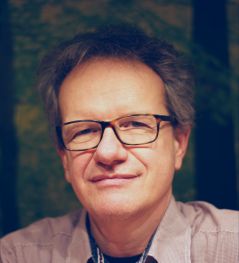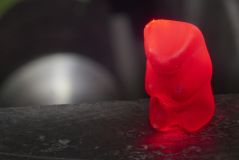MLZ is a cooperation between:
 > Technische Universität München
> Technische Universität München > Helmholtz-Zentrum Hereon
> Helmholtz-Zentrum Hereon
 > Forschungszentrum Jülich
> Forschungszentrum Jülich
MLZ is a member of:
 > LENS
> LENS > ERF-AISBL
> ERF-AISBL
MLZ on social media:

MLZ (eng)
Lichtenbergstr.1
85748 Garching
04.04.2019
Christoph Hugenschmidt appointed as adjunct professor
The Physics Department of the Technical University of Munich (TUM) has appointed PD Dr. Christoph Hugenschmidt adjunct professor for the subject “Physics with positrons” at the chair E21 on 15 January. Thereby TUM recognizes the scientific achievements of the 49-year-old as well as his years of engagement to teaching. In an interview, Prof. Dr. Christoph Hugenschmidt explains the research field of positrons, which he newly established at TUM.
You have been appointed as adjunct professor because you have made significant progress in positron research.
First, it was a unique opportunity for me to have such a large-scale research facility as the FRM II in the immediate vicinity of other institutes and faculties – especially the Physics Department – of the Technical University of Munich. By combining both development of the intense positron source at the FRM II and the work of many motivated students, I was able to establish the physics with positrons as a completely new field of research at the TUM.
How are the antiparticles of electrons generated at the research neutron source?
The tip of a beam tube of the FRM II contains a cap made of cadmium. By capturing thermal neutrons in cadmium, high-energy gamma radiation is released. In platinum foils, the energy of this gamma radiation is converted into mass according to Einstein’s most famous formula E = mc2: electrons and their antiparticles, the positrons, are formed in equal parts. The special feature of our facility is the efficient production of monoenergetic positrons; this means that NEPOMUC delivers a low-energy positron beam with low energy spread.
Why was it so important to build a positron source at the FRM II?
Prof. Dr. Klaus Schreckenbach, the first technical director of FRM II, had already come up with the idea for a neutron-induced positron source in the late 1980s, which might be realized at a reactor. In 1998, Klaus Schreckenbach and I as a freshly graduated physicist started out in an extremely fruitful collaboration with the construction of the positron source. With the commissioning of the FRM II, it produced positrons for the first time and was even improved in 2012. NEPOMUC (neutron induced positron source Munich) produces a beam with more than one billion positrons per second; this is 1000 times more positrons than a standard positron beam on a laboratory scale. It is hence immediately clear that a completely new physics has become possible.
Five different spectrometers are in use at NEPOMUC – a worldwide unique range of measuring possibilities. How are the antiparticles applied there?
On the one hand, we carry out various experiments together with our external users at NEPOMUC. On the other hand, in our 13-member research group we perform our own experiments, often in cooperation with other institutes in nuclear and particle physics as well as in condensed matter and surface physics. For example, we study a bound state of two electrons and a single positron – the three-body problem par excellence. However, there is also very application-related research. For example, we investigated the electrode material for lithium-ion batteries or analyzed the local structural changes in high-performance light metal alloys produced during a laser welding process.
Which experiments do you plan in the future with the positrons?
In our own working group, we want to commission a completely new instrument this year, which will enable us to study structures on solid surfaces with the utmost precision. Also new and very successful is a joint project with the Max Planck Institute for Plasma Physics in Garching and Greifswald. For the first time we will try to create a pair plasma of electrons and positrons in order to fundamentally understand the physics of a plasma. This is extremely exciting. Also astrophysical issues are addressed since such matter-antimatter plasmas are suspected, for example, in the vicinity of black holes.
In addition to the positron source at the FRM II, you also operate three more positron spectrometers. What are these used for?
A spectrometer is located at the Maier-Leibnitz accelerator here in Garching. As part of the Collaborative Research Center TRR80, we are investigating the electronic structure of materials. We operate two other small spectrometers in the laboratory of the Physics Department to introduce students to positron experiments as part of practical courses. Here, for example, we measured how long positrons survive in gelatin – the famous gummy bear experiment. Measurements of this kind are used in the development of capsules for medications, which often consist of gelatin.
The neutron-induced positron source has found many imitators worldwide.
This is largely due to the attractiveness of the Garching source. Yes, it has been shown that we are still very attractive for users and we have inspired other scientists. Similar positron sources have been developed at research reactors in Japan and the USA. In addition, on our initiative, a completely new facility in Romania is under construction to produce polarized positrons.
Further information:
https://www.frm2.tum.de/en/the-neutron-source/secondary-sources/positron-source/
https://mlz-garching.de/englisch/instruments-und-labs/positrons.html
https://www.sces.ph.tum.de/en/research/positron-physics/
Cooperation partner: Bundeswehr University Munich
Contact:
Prof. Dr. Christoph Hugenschmidt
Fachgebiet für Physik mit Positronen
Lichtenbergstr. 1, 85747 Garching, Germany
Christoph.Hugenschmidt@frm2.tum.de
Tel.: +49 89 289 14600
Related News
-
15.12.2018
Trapped antimatter
MLZ is a cooperation between:
 > Technische Universität München
> Technische Universität München > Helmholtz-Zentrum Hereon
> Helmholtz-Zentrum Hereon
 > Forschungszentrum Jülich
> Forschungszentrum Jülich
MLZ is a member of:
 > LENS
> LENS > ERF-AISBL
> ERF-AISBL
MLZ on social media:







